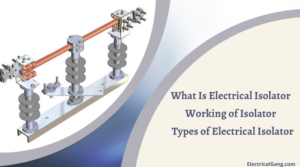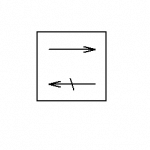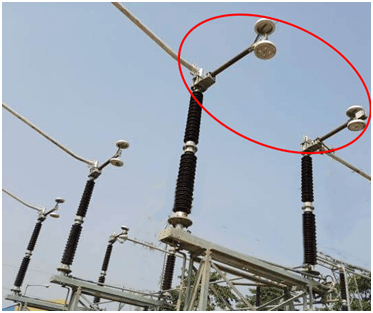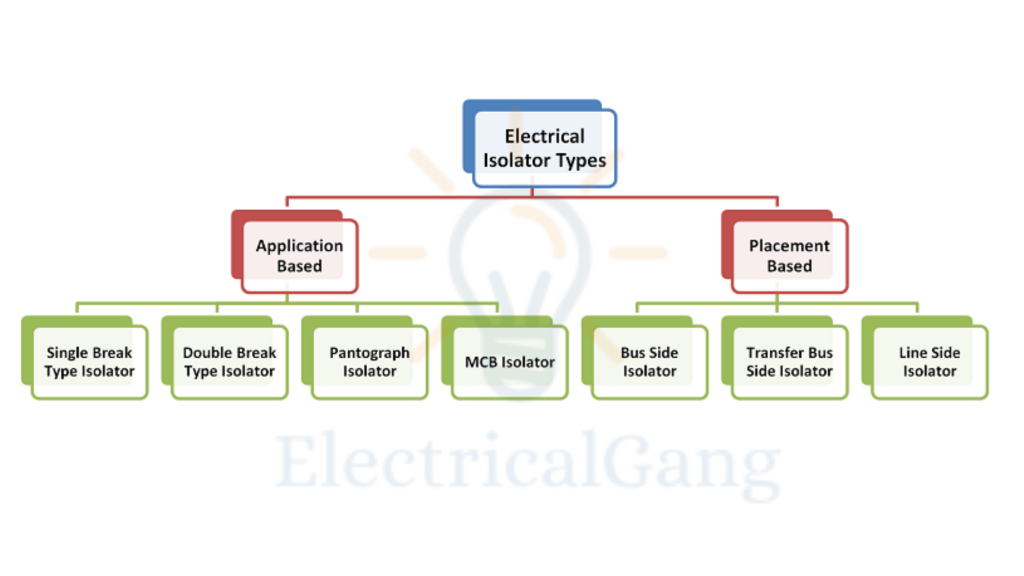
Hello friends, in today’s article, see what is Electrical Isolator is, what are its types, and what is its use. Read this article for detailed information.
Introduction:
The insulator is a type of switching device. Its main function is to ensure that no current flows in the circuit during protection. This acts as insulation to separate the parts of the circuit. This switch is used in various places like industrial power transmission lines etc.
Sub-voltage type isolation switches are used in the substation to allow the separation of equipment such as transformers and circuit breakers. The isolator can be operated automatically or manually.
Suggested Read: What is Suspension Insulator? | The Definitive Guide
What is Electrical Isolator?

Isolators can be defined by covering something. The time required is to complete the electrical circuit i.e. to open the circuit. This is a mechanical type switch.
The isolator switch is always used to open the electrical circuit in the no-load condition. It is not advisable to operate this in the timeline in which the current is flowing and it has not yet become a switch that can be operated in live operation.
The isolator is usually mounted at the end of the transmission line so that the circuit breaker can be easily repaired without any risk.
Suggested Read: Electrical Substation Components and Their Workings
The function of the Electrical Isolator is very simple and can be operated in various ways such as fully automatic semi-automatic or manually operated. An electrical Isolator can also be used as a switch in some circumstances which can be turned on or off as required.
But often electrical isolator to the transmission line, transformer. Fixed space is installed to keep space like grid station separate Whose figure is as follows.

This is used to separate the conductor from the transmission tower, also known as the transmission insulator, as shown in the figure above. Thus the isolator is used to protect it from the grounding loop. Such as reducing the risk of accidental passage of electric current flowing toward the ground.
Isolator switches are especially used in grid station small substations. The time it takes to maintain this is when the transformer or circuit breaker is separated from the high transmission line very easily and carefully.
The most commonly used isolator works at the time of the problem. Not to remove the N or high voltage arcs caused by a disturbance in the electric conductor. In high-voltage power systems, isolators are used in conjunction with circuit breakers to provide an extra level of safety. The circuit breaker is opened first so the isolator is also opened after the power circuit is disconnected.
And exactly the reverse process is done when shutting down, first, the isolator is closed then the circuit breaker is closed. And the power works as before.
The picture below shows the isolator in the disconnected state under the power substation.
 It can be seen that it is a physical and mechanical system. And it can be run manually or it can be done automatically. The isolator symbol is represented by the following image.
It can be seen that it is a physical and mechanical system. And it can be run manually or it can be done automatically. The isolator symbol is represented by the following image.
Isolator applications have been found to provide safety during the service and maintenance of power systems, power grids, and transmission lines. It is used in homes to provide the necessary safety and security against any electrical problem.

Types of Electrical Isolators:
There are many types of isolators available in the market. The choice of isolator depends on its need and application. The number is divided according to the application and placement as shown below

Isolators can be classified into four types based on the application:
#1. Single Brake isolator:
#2. Double Brake isolator:
#3. Pantograph isolator:
#4. MCB isolator:
#1. Single Break Type Isolators:
In this type of isolator, hand contact is separated into two elements. The first-hand contact has male contact, as well as the second-hand contact, has female contact.
Post-insulator rotation causes the arm contact to shift at which the hand contacts are fixed. The post-insulator rotation stacks are opposite to each other which makes the insulator close by closing the hand contact.
Rotate the post-insulator counter-rotation stacks to open the arm contact, as well as an insulator, in the off condition. Generally, a motor-operated isolator is used although an emergency manual-operated isolator is also provided.
Suggested Read: What is a Substation? | Types of Substations
#2. Double Brake isolator:
This type of insulator has three loads of post-insulators. The middle insulator has a flat male or tubular contact that can be rotated directly by the spin of the middle post insulator.
The rotation of the middle post insulator can be done by the lever mechanism at the bottom of the post insulator, As well as the manual operation of the isolator through the mechanical knot (operating handle) or the motor operation related to the motor (use of the motor).
#3. Pantograph isolator:
The pantograph-type isolator allows current switchgear installation and requires minimal space. This type of insulator includes a post-insulator as well as an operating insulator.
The isolator can be divided into 3 parts based on the placement based.
1. Bus side isolator: The bus side isolator is used to connect to the main bus.
2. Line Side Isolator: The line side isolator is connected to the line side by a feeder.
3. Transfer Bus Side Isolator: The displaced bus side is connected by the main bus of the isolator transformer.
Electrical Isolator Operation:
Electrical isolators can be made in two ways. These are as follows:
- Opening Operation of Electrical Isolator:
- Closing Operation of Electrical Isolator:
#1. Opening Operation of Electrical Isolator:
- Open the main circuit at the beginning.
- Then separate from the load of the system and then open the isolator.
- Turning off the earthing switch can be made with an isolator with an interlock system.
- This means that the earth switch can only be turned off when the isolator is open.
#2. Closing Operation of Electrical Isolator:
- Disconnect the earth switch.
- Close the isolator.
- Turn off the circuit breaker.
The biggest difference between an isolator and a circuit breaker is that the circuit breaker can be turned on and off in the current power condition while this is not possible in an isolator. Read our article to know more about this.
Suggested Read: Difference Between Circuit Breaker and Isolator
Applications of Electrical Isolator:
Isolator applications include the following:
- The application of isolators includes high-voltage devices such as transformers.
- It is protected externally or with a lock system to prevent accidental use.
- Isolator in substation: When there is a defect in the substation, then the isolator cuts off part of the substation.
Like this post? Share it with your friends!
Suggested Read –
- What is a Signal Isolator? | A Complete Guide
- Highway/Street Light Names And Functions
- How to Fix YouTube TV Freezing Issues in Easy Steps
- How to Solve LG Content Store Not Working Problem?
- What is a Phototransistor | Construction of Phototransistor
- What is a Single Phase Transformer | Construction of Single Phase Transformer